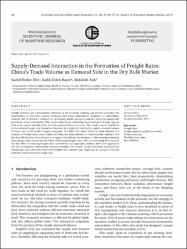| dc.contributor.author | Efes, Kamil Özden | |
| dc.contributor.author | Baser, Sadik Ozlen | |
| dc.contributor.author | Acik, Abdullah | |
| dc.date.accessioned | 2021-06-05T19:56:05Z | |
| dc.date.available | 2021-06-05T19:56:05Z | |
| dc.date.issued | 2019 | |
| dc.identifier.issn | 1332-0718 | |
| dc.identifier.issn | 1846-8438 | |
| dc.identifier.uri | https://doi.org/10.31217/p.33.1.5 | |
| dc.identifier.uri | https://hdl.handle.net/20.500.12960/141 | |
| dc.description | 0000-0001-6632-2617 | en_US |
| dc.description | 0000-0003-4542-9831 | en_US |
| dc.description | 0000-0001-7087-5337 | en_US |
| dc.description | WOS:000473317900005 | en_US |
| dc.description.abstract | Freight revenues are a fundamental objective of the maritime industry, and provide a baseline for stakeholders to plan their current strategies and future investments. Reduction of uncertainty-induced risk is therefore essential for predicting market prospects and for achieving sustainable growth for sector participants. This can be achieved by conceiving the formation of freight rates as well as the macro variables that have the greatest impact on rates. This study aims to contribute to the existing freight rate formation literature by empirically testing the supply-demand balance of China, one of the world's largest economies. The Baltic Dry Index (BDI) has been selected as a measure of freight rates, trade volume of China has been selected as a demand-side indicator and the dry bulk fleet has been selected as a supply-side indicator in the model. It has been hypothesized that a larger trade volume has the effect of increasing freight rates, while an increasing fleet capacity has the effect of reducing freight rates. Correlation and regression analyses have been applied to test the econometric relationships between variables. The results of the study have confirmed the hypotheses, and it has been found that freight rates reacted more vigorously to changes in the dry bulk fleet, which forms the supply side. | en_US |
| dc.language.iso | eng | en_US |
| dc.publisher | Univ Rijeka, Fac Maritime Studies | en_US |
| dc.relation.ispartof | Pomorstvo-Scientific Journal on Maritime Research | en_US |
| dc.rights | info:eu-repo/semantics/openAccess | en_US |
| dc.subject | Freight Rates | en_US |
| dc.subject | Supply-Demand Equilibrium Model | en_US |
| dc.subject | China's Economy | en_US |
| dc.subject | The Baltic Dry Index | en_US |
| dc.subject | Dry Bulk Fleet | en_US |
| dc.title | Supply-Demand Interaction in the Formation of Freight Rates: China's Trade Volume as Demand Side in the Dry Bulk Market | en_US |
| dc.type | review | en_US |
| dc.department | Denizcilik Fakültesi, Gemi Makineleri İşletme Mühendisliği Bölümü | en_US |
| dc.department-temp | [Efes, Kamil Ozden] Piri Reis Univ, Maritime Fac, Dept Marine Engn, Istanbul, Turkey; [Baser, Sadik Ozlen; Acik, Abdullah] Dokuz Eylul Univ, Maritime Fac, Dept Maritime Business Adm, Izmir, Turkey | en_US |
| dc.contributor.institutionauthor | Efes, Kamil Özden | |
| dc.identifier.doi | 10.31217/p.33.1.5 | |
| dc.identifier.volume | 33 | en_US |
| dc.identifier.issue | 1 | en_US |
| dc.identifier.startpage | 46 | en_US |
| dc.identifier.endpage | 55 | en_US |
| dc.relation.publicationcategory | Diğer | en_US |

















